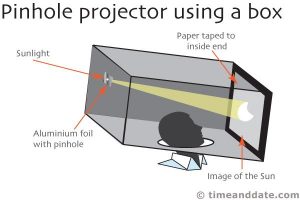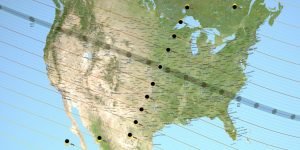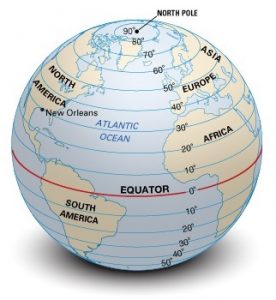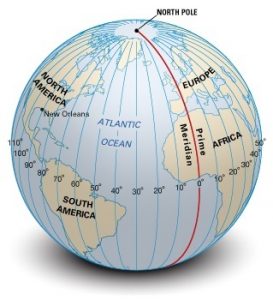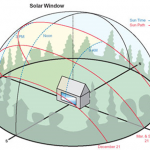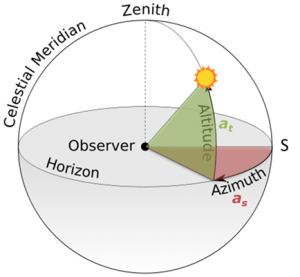Building for Hurricanes
Activity adapted by NASA’s Precipitation Measurement Missions from PBS Design Squad activity High Rise. Click HERE for PDF of the activity and teacher’s guide or view online.
For similar design challenges involving lateral wind gusts, see TeachEngineering’s Recycled Towers [Grades 3-5] and Newspaper Tower [Grades 6-8] A similar PBS Design Squad activity using newspaper can be found HERE.
Summary
In this engineering design challenge about building in hurricane-prone regions, students learn that a solid base helps stabilize a structure by constructing, testing, and redesigning a tower that can support a tennis ball at least 18 inches off the ground while withstanding the wind from a fan.
Grade level: K-12
Time: 30 to 60 minutes
Learning objectives
After doing this activity, students should:
- Understand that some shapes increase a building’s stability
- Be able to follow the engineering design process to improve on a design
- Identify which designs can and cannot withstand the self-weight of the tower as well as a lateral wind load.
- Explain how their towers worked to withstand the lateral wind load using general engineering terms
Learning standards
Next Generation Science Standards
- Define a simple design problem reflecting a need or a want that includes specified criteria for success and constraints on materials, time, or cost. (Grades 3 – 5)
- Generate and compare multiple possible solutions to a problem based on how well each is likely to meet the criteria and constraints of the problem. (Grades 3 – 5)
- Plan and carry out fair tests in which variables are controlled and failure points are considered to identify aspects of a model or prototype that can be improved. (Grades 3 – 5)
- Evaluate competing design solutions using a systematic process to determine how well they meet the criteria and constraints of the problem. (Grades 6-8)
- Analyze data from tests to determine similarities and differences among several design solutions to identify the best characteristics of each that can be combined into a new solution to better meet the criteria for success. (Grades 6 – 8)
International Technology and Engineering Educators Association
- Identify and collect information about everyday problems that can be solved by technology, and generate ideas and requirements for solving a problem. (Grades 3 – 5)
- Test and evaluate the solutions for the design problem. (Grades 3 – 5)
- Design is a creative planning process that leads to useful products and systems. (Grades 6 – 8)
- There is no perfect design. (Grades 6 – 8)
- Requirements for design are made up of criteria and constraints. (Grades 6 – 8)
- Design involves a set of steps, which can be performed in different sequences and repeated as needed. (Grades 6 – 8)D
- Brainstorming is a group problem-solving design process in which each person in the group presents his or her ideas in an open forum. (Grades 6 – 8)
- Modeling, testing, evaluating, and modifying are used to transform ideas into practical solutions. (Grades 6 – 8)
- Test and evaluate the design in relation to pre-established requirements, such as criteria and constraints, and refine as needed. (Grades 6 – 8)
- Structures rest on a foundation. (Grades 6 – 8)
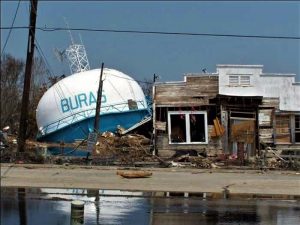
Engineering connection
Students act as civil and structural engineers as they design and build towers to withstand the forces of high winds, such as might occur during storms and hurricanes.
Introduction/Motivation
Whether you live in an area prone to hurricanes or not, you’ve seen images of the destruction caused by such storms. (Like the water tower that toppled in Louisiana during Hurricane Katrina.) In late August through early September 2017, Hurricane Harvey inundated Houston, Texas, dropping so much rainfall that maps had to be redesigned because the current system didn’t go high enough. Then Irma ripped through the Caribbean, followed by Hurricane Maria’s category 5 fury that wreaked havoc in Puerto Rico.
Builders in areas at risk for hurricanes need to plan for that in their designs. That is the role you will take on today—designing a building that can withstand a (simulated) hurricane using limited supplies in a limited amount of time.
Damage to buildings can come because of wind, storm surge, or heavy rainfall leading to flooding. For today’s activity, we will focus primarily on wind damage, although you may choose to think about the others as well. The tower must be as tall as you can make it, but also stable enough to stand up to a wind load since it will be built in a hurricane-prone region.
Engineers face similar design constraints in the real world—with tight budgets, material limitations and deadlines. An engineering team that can design a structure to meet the objectives with the fewest materials (hence, less cost), is favored over other companies that cannot utilize the given materials as effectively.
When you are brainstorming about your design approach in your teams, think about the real skyscrapers you have seen as inspiration, including the tallest buildings and towers in your home town. What are their shapes? What are their foundations like?
Challenge
Your challenge is to build a freestanding tower that can support a tennis ball as high as possible off the ground (measured from the bottom of the tennis ball) while withstanding the wind from a fan. (Optional extra tough challenge: add a spray bottle to represent rain!)
Build a tower that can support a tennis ball at least 18 inches off the ground while withstanding the wind from a fan.
Materials
For each group:
- Index cards (4-8)
- Straws (~10)
- Craft sticks (4-8)
- String (~3 feet/~1 meter)
- Pipe cleaners (4-8)
- Tape (limited or unlimited amount – depending on level of challenge)
- Optional: Building surface (tray, cardboard, or piece of wood)
To share:
- Electric fan
- Tennis ball
- Scissors
- Ruler
- Capture sheet for planning and analysis of results (or just paper and pencil). Click HERE for PDF.
- Optional: Spray bottle with water for testing
- Copy of challenge instructions
- Optional: Copy of tower/structure examples from PowerPoint. (optional)
Procedure 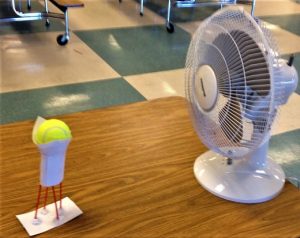
Instructions, the challenge, and examples of structures are included in PowerPoint presentation. This could be projected on a screen, or a copy made for each group.
Introduce the challenge. Be sure to remind the students that the height of the tower is measured from the ground to the bottom of the tennis ball as specified in the directions. This prevents designs that sit the tennis ball on the ground and built a tower around it, which defeats part of the purpose of the design challenge: to support weight. Also, this means that antenna-like protuberances on the top won’t add to their height value.
You can choose to allow them to attach tape to the tennis ball or just rest it on or in the tower—just be sure to specify which ahead of time.
If you wish to make this a competition, here are a few possibilities for scoring:
- With a single-speed fan, multiply the height of the tower (measured to the bottom of the tennis ball) times the amount of time the tower stands before collapsing or blowing over.
- With a variable speed fan, you can start on the lowest speed and after a fixed period of time turn up the fan to the next level, then after the same length of time to the third level. The score could then be the level of the fan times the height times the amount of time withstood at the highest power the fan was on before the tower blew over or collapsed. For example, a tower that is 20 cm tall and stood for 15 seconds at level 2 (medium) power before collapsing would score 2 * 20 * 15 = 600 points.
For either of the above options, you will probably want to determine ahead of time a maximum amount of time you will leave the tower in front of the fan—say 30 to 45 seconds. If several towers achieve that maximum, the tallest one wins!
This is also an opportunity to discuss how there are often different ways to solve the same problem. Show examples of different structures and shapes the students might use when designing their tower. Examples can be found in the slides – including the Eiffel Tower, skyscrapers, and water towers – or the teacher can supply.
Once teams have decided on a design, have them build their towers. Save time at the end for students to share their designs and test with the fan – which can be observational or framed as a contest between teams.
Brainstorm
Divide into teams of two or three. Before you begin designing, brainstorm answers to the following questions. Record and sketch your ideas on a piece of paper or on the capture sheet.
- Which combination of materials will make the tower as tall as possible (measured to the bottom of the tennis ball)?
- What tower shapes could you use? Should your base be round? Square? Triangular?
- Can you be creative about using the materials in an unexpected way?
- How can you get the tower to be freestanding, not taped to the table, and yet not fall over?
- Think about the forces on the tower, wind from the side and gravity pulling down. How you will build your tower to resist them?
As you brainstorm designs for your tower, think about other structures and how they stand up. For example, a tent combines flexible and rigid materials to make a frame and covering that can stand on its own.
Build, Test, Redesign
Once you’ve got a tower to test, put it one foot away from the fan. See how your tower responds when you turn the fan speed on low.
If there is time after testing, redesign your tower based on what you learned from the testing. For example, if the tower tips over, the tennis ball won’t stay in place, or the weight of the tennis ball collapses the tower.to improve their performance, or simply discuss what worked well and what didn’t in their designs.
Activity Scaling
- To make the challenge a bit easier, give each group a roll of tape and allow them to use as much as they’d like.
- For older students, add a rain simulation rain with a spray bottle. (You may want to do the testing outside or put down plastic sheeting. Make sure to remind students that they will have to move their tower to the testing site, so it must not be taped to the table.)
- For younger kids, allow more time and materials, and suggest some design ideas.
- For high school students, allow less time and fewer materials.
Troubleshooting tips
- For testing, ensure all towers are placed the same distance away from the fan—about a foot works well for most models.
- Move the fan to the tower if the structure is hard to move.
- Instead of tape, consider giving each group part of a sheet of sticky mailing labels. They are easier to have ready to hand out to multiple groups (such as in pre-made supply bins), and ensure that each group gets the same exact same quantity if you are framing it as a competition.
- If students are struggling, consider allowing more time or providing more materials.
- If students are struggling for design ideas, suggest they think about tall buildings they may have seen in cities or in their own towns that have cylindrical shapes or large foundations or triangular trusses for support. If necessary, suggest more specifics, such as the idea of rolling the paper for strength and/or using a triangular or wider base.
Additional Resources
Skyscraper Basics. Primer on tall buildings from PBS’s Building Big series includes a forensic engineering skyscraper challenge to investigate building collapses and leaning towers.
Weather and Climate Science Education. Interactive water-cycle games, videos on a new multidimensional model for studying hurricanes. and other teaching resources from NASA’s Precipitation Measurement Missions.
Extreme Weather News. The latest on hurricane tracks, rainfall amounts, and other storm news from NASA’s Precipitation Measurement Missions.
NASA’s Hurricanes and Tropical Storms webpage. Thermal images, videos, and more.
Structure basics. TechnologyStudent.com has diagrams and examples of different types and parts of structures, such as struts and ties, sections and beams, and frames, as well as other building and design activities.
NASA’s Rain EnGAUGE weather activities include building and testing a rain gauge and the hurricane tower challenge.
Adapted from PBS Design Squad activity High Rise. Click HERE for original Design Squad activity in English and Leader/Teacher Guide. Click HERE for Spanish. A similar Design Squad activity using newspaper can be found HERE.
Filed under: Class Activities, Grades 6-8, Grades 9-12, Grades K-5 | Comments Off on Building for Hurricanes









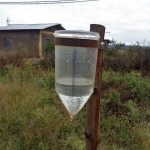
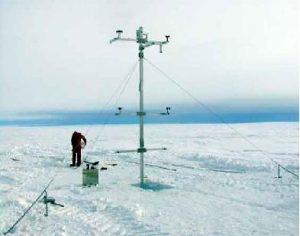 Now let’s try to imagine how people predicted the weather before engineers and scientists developed modern forecasting equipment (as shown in the photo, left, of an automatic weather station). How do you predict the weather? For example, when you see a clear blue sky on a warm day, what do you expect to happen? Probably not much — your experience of this weather pattern has taught you that clear blue skies on warm days mean fair weather. What if you looked up at the sky and saw a gray cloud, hanging low in the sky? You know from experience that dark gray clouds usually bring rain or snow. In both cases, you are relying on the observation of known patterns to predict the weather. Observing weather patterns over time to predict the future state of the weather is how people forecast the weather for thousands of years before engineers and scientists developed modern weather forecasting equipment.
Now let’s try to imagine how people predicted the weather before engineers and scientists developed modern forecasting equipment (as shown in the photo, left, of an automatic weather station). How do you predict the weather? For example, when you see a clear blue sky on a warm day, what do you expect to happen? Probably not much — your experience of this weather pattern has taught you that clear blue skies on warm days mean fair weather. What if you looked up at the sky and saw a gray cloud, hanging low in the sky? You know from experience that dark gray clouds usually bring rain or snow. In both cases, you are relying on the observation of known patterns to predict the weather. Observing weather patterns over time to predict the future state of the weather is how people forecast the weather for thousands of years before engineers and scientists developed modern weather forecasting equipment.
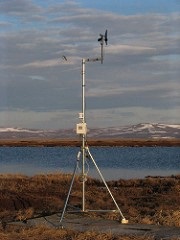


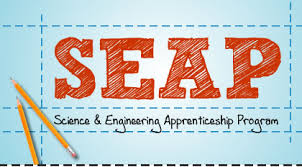
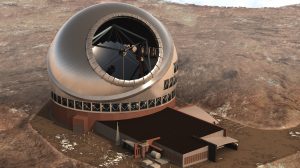
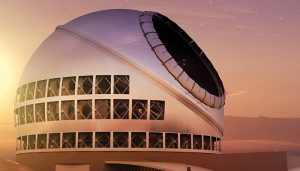
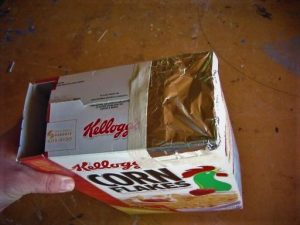 un dwindles, shadows become sharper – to the point where you can see the hairs on your arm. The feeble light just before and after totality also creates beautiful, 360-degree sunset colors on the horizon.
un dwindles, shadows become sharper – to the point where you can see the hairs on your arm. The feeble light just before and after totality also creates beautiful, 360-degree sunset colors on the horizon.